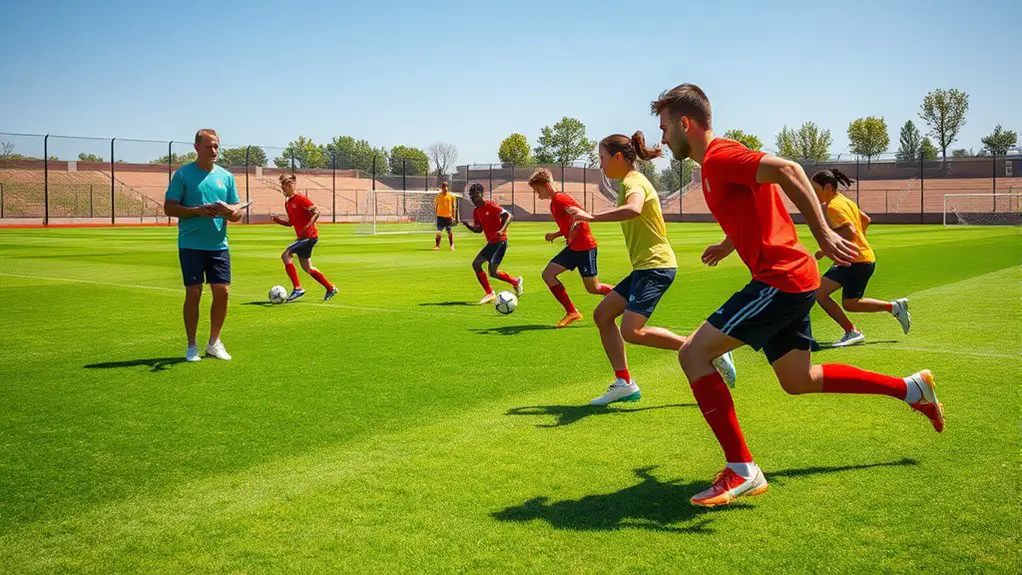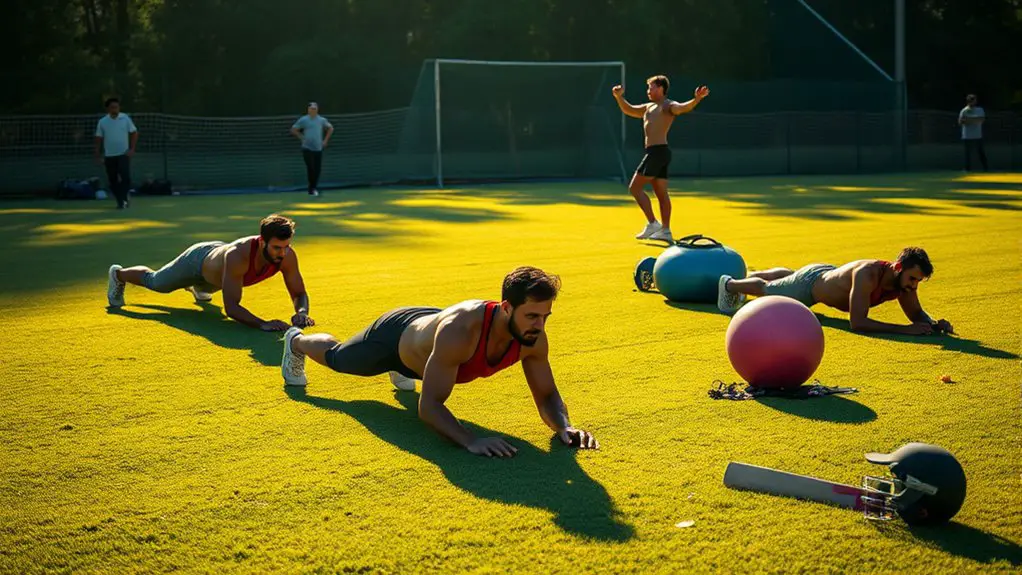To excel in soccer, you'll want to focus on agility drills like ladder and cone workouts, plus plyometric exercises such as box jumps for explosive power. Strength training is essential for core stability, using planks and medicine ball throws. Incorporate interval training to boost your endurance and speed workouts for acceleration. Don't forget flexibility routines to prevent injuries and ball control drills to sharpen your technique. There's much more to enhance your game, so keep exploring!
Agility Drills for Quick Footwork
When it comes to soccer, having quick footwork can make all the difference in your performance. Agility drills are your best friends for achieving that fluidity and speed you crave on the field. Start with ladder drills, focusing on precise, quick steps to enhance your foot placement and balance. You can also incorporate cone drills, which help improve your ability to change direction rapidly. Try the shuttle run; it's a fantastic way to build explosive speed while maintaining control. Don't forget to practice your lateral movements, as they're essential for dodging defenders. By consistently integrating these exercises into your routine, you'll find yourself feeling freer and more agile during games, allowing you to express your skills with confidence.
Plyometric Exercises for Explosive Power
Plyometric exercises are vital for soccer players looking to develop explosive power on the field. These high-intensity movements help you generate speed and strength, which can give you an edge during critical plays. Incorporate exercises like box jumps, depth jumps, and lateral bounds into your routine. These drills engage fast-twitch muscle fibers, allowing you to sprint, jump, and change direction with ease. Don't forget to focus on proper form; it'll maximize your gains and reduce the risk of injury. Aim for 2-3 sessions a week, mixing in rest days for recovery. With dedication, you'll feel the difference in your performance, enabling you to release your full potential during matches. Embrace the challenge and enjoy the freedom of your newfound power!
Strength Training for Core Stability
Core stability is essential for soccer players, as it supports overall balance and strength during dynamic movements on the field. To enhance your core, incorporate exercises like planks, Russian twists, and medicine ball throws into your routine. These movements not only strengthen your abdominal muscles but also improve your posture and stability, allowing you to maneuver more effectively. Aim for three sets of 10-15 reps for each exercise, focusing on maintaining proper form. Don't shy away from using resistance bands or weights to increase the challenge. Remember, a strong core helps you maintain control while dribbling, shooting, and defending. So, embrace these strength training exercises, and you'll feel the difference in your performance on the pitch!
Interval Training for Endurance
To enhance your endurance on the soccer field, incorporating interval training into your workout routine can make a significant difference. This training method involves alternating between high-intensity bursts and lower-intensity recovery periods. For example, sprint for 30 seconds, followed by a minute of light jogging or walking. This not only boosts your aerobic capacity but also mimics the stop-and-start nature of a soccer match, preparing your body for game situations.
You can customize intervals to fit your fitness level, gradually increasing intensity as you improve. Aim for at least two sessions per week, and you'll notice enhanced stamina and quicker recovery on the pitch. Embrace the challenge, and watch your endurance soar, giving you the freedom to dominate the game!
Speed Workouts to Enhance Acceleration
While enhancing your endurance is essential, speed workouts are equally important for improving your acceleration on the soccer field. To get started, incorporate sprints into your training. Try 10-20 meter sprints, focusing on explosive starts. Short, intense intervals can help you build the quickness you need to outpace defenders.
Another great drill is the shuttle run, which boosts agility and acceleration. Set up cones about 10-15 meters apart, sprint to a cone, touch it, and race back. Repeat this several times.
Don't forget about hill sprints—they're fantastic for building power. Sprinting uphill forces your legs to work harder, enhancing strength and acceleration. Keep challenging yourself. With consistent speed workouts, you'll notice significant improvements in your game!
Flexibility Routines for Injury Prevention
Incorporating flexibility routines into your training can considerably reduce the risk of injuries on the soccer field. Stretching not only enhances your range of motion but also prepares your muscles for the demands of the game. A consistent routine helps you stay agile and responsive, giving you the freedom to play your best without worrying about strains or pulls.
Here's a simple flexibility routine you can follow:
| Exercise | Duration |
|---|---|
| Hamstring Stretch | 30 seconds |
| Quadriceps Stretch | 30 seconds |
| Hip Flexor Stretch | 30 seconds |
| Shoulder Stretch | 30 seconds |
| Calf Stretch | 30 seconds |
Make these stretches a regular part of your warm-up or cool-down, and you'll feel the difference on the field!
Ball Control Drills for Improved Technique
Mastering ball control is essential for any soccer player looking to elevate their game. It's all about feeling confident with the ball at your feet and being able to maneuver it effortlessly. Here are some effective drills to enhance your technique:
- Juggling: Keep the ball in the air using your feet, thighs, and head. It boosts touch and coordination.
- Cone Dribbling: Set up cones and weave through them while keeping control. This sharpens your agility and precision.
- Passing Against a Wall: Pass the ball against a wall and receive it back. Focus on controlling the return with both feet.
Incorporating these drills into your routine will not only improve your skills but also make the game more enjoyable. Get out there and practice!
Recovery Strategies to Optimize Performance
After honing your ball control skills, it's important to focus on recovery strategies to optimize your performance on the field. You've pushed your body to its limits, and now's the time to help it bounce back. Prioritize sleep; it's your body's natural repair system. Hydrate well to flush out toxins and keep your muscles functioning smoothly. Incorporate active recovery days with light activities like walking or yoga to stimulate blood flow without overexerting yourself. Stretching post-training helps maintain flexibility and reduces soreness. Don't underestimate the power of nutrition; refuel with a mix of carbs and protein to aid muscle recovery. Finally, consider massages or foam rolling to relieve tension. Listen to your body; it knows best what it needs to recover.
Frequently Asked Questions
How Often Should I Train to See Improvements?
If you train consistently, like a soccer player who practices five times weekly, you'll likely see improvements faster. Aim for at least three to four sessions weekly, balancing intensity with recovery for ideal progress.
What Should I Eat Before Training Sessions?
Before training, you should eat a balanced meal with carbs for energy and protein for recovery. Try oatmeal with fruit or a smoothie; it'll keep you fueled and focused during your sessions.
How Can I Prevent Overtraining Injuries?
To prevent overtraining injuries, you've gotta listen to your body. Make certain you're resting adequately, mixing up your workouts, and incorporating recovery techniques. Keep a balanced approach to training, so you can enjoy your fitness journey.
What Footwear Is Best for Soccer Training?
When choosing footwear for soccer training, you'll want cleats that provide good traction and support. Look for lightweight options that fit snugly, allowing freedom of movement while protecting your feet during intense sessions.
How Long Should a Typical Training Session Last?
A typical training session should last around 60 to 90 minutes. It's crucial to balance intensity and recovery, so you're not only improving skills but also avoiding burnout. Listen to your body and adjust accordingly.




